Tom's Hardware Verdict
The be quiet! Dark Rock TF 2 exhibits excellent cooling ability and near-silent operation, though it faces stiff competition from its own be quiet! brethren. But as either a performance option where the clearance is the primary limiting factor, or for those who favor downdraft coolers, it’s a solid choice.
Pros
- +
Excellent build quality
- +
Extremely silent operation
- +
Low(er) profile for compact builds
Cons
- -
Expensive
Why you can trust Tom's Hardware
In the world of CPU cooling, be quiet! has been busy lately. We recently tested (and liked) the company’s Shadow Rock Slim 2 budget air cooler. Now the company is adding to its Dark Rock series with a high-end cooler defined as a top flow (downdraft) ‘TF’ model, aptly called the Dark Rock TF 2. Making use of six copper heatpipes and a pair of whisper-quiet Silent Wings 3 fans, be quiet! has performed some metallurgy origami to create its newest stealthy air cooler.
As a dual-heatsink downdraft cooler, the Dark Rock TF 2 utilizes a pair of large+small fin stacks, turned on their side to allow for compact or cramped builds where traditional coolers might exceed installation clearance.
Specifications
| Height | 5.125" / 130.2mm |
| Width | 6.5" / 165.1mm |
| Depth | 5.50" / 139.7mm |
| Base Height | 2.0" / 50.8mm |
| Assy. Offset | 0.0" (centered) |
| Cooling Fans | (1) 135 x 25mm |
| Connectors | (2) 4-pin PWM |
| Weight | 34.1 oz / 966g |
| Intel Sockets | 115x, 1200, 2011*, 2066* |
| (* square ILM mounts only) | |
| AMD Sockets | AM4, AM3(+) |
| Warranty | 3 years |
| Web Price | $86 |
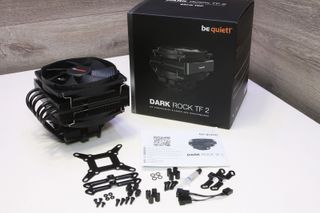
The be quiet! Dark Rock TF 2 ships with mounting hardware suitable for most current Intel desktop sockets and AMD’s AM3(+)/AM4 socket CPUs. All the hardware also arrives dressed in the company’s usual stealth-black color scheme. A 4-pin PWM splitter allows for single-header fan control and a syringe of non-descript thermal paste is included--presumably it’s be quiet! compound.
be quiet! covers the Dark Rock TF 2 with a 3 year warranty.
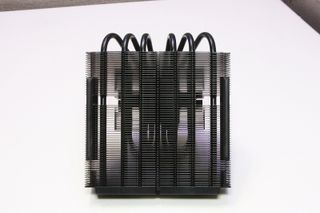
The Dark Rock TF 2 features a downdraft design, meaning the cooling fans move air down through the cooler toward the motherboard rather than through the cooling tower. Making use of six heatpipes, the large, upper cooling stack evenly distributes heat across the broad face of the cooler directly below the top-mounted fan.
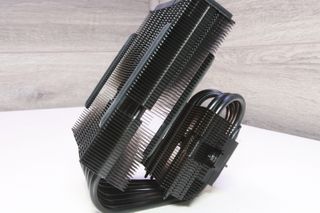
Below, the smaller heatsink sits centered beneath the middle fan, collecting the folded-ever ends of the heatpipes, while providing some surface area to dissipate any heat that doesn’t make its way further up the cooler’s pipes. From one end to the other, the six heatpipes pass between a milled base plate, the mounting block and fixed hardware brace, and wrap up and around to form the folded dual-heatsink downdraft design of the Dark Rock TF 2.

A pair of 135mm fans accompany the Dark Rock TF 2; one is a Silent Wings and the other as a Silent Wings 3 variant. Each are 4-pin PWM managed and rated up to 1400 RPM.
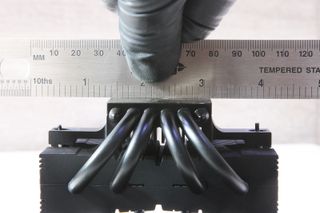
The milled base of the Dark Rock TF 2 is completely flat, leaving ambient light unable to squeeze through between our steel ruler and the cooler’s mounting surface. Beneath the small lower cooling tower, we can see a milled, broad-tooth heat exchanger protruding between the heatpipes and lower tower cooling fins, providing even more surface area for the cooler to utilize.
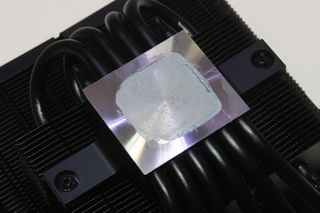
The milled 40mm x 43mm Dark Rock TF 2 heatsink plate allows for a quality thermal compound, and is quite capable of universal paste distribution over the CPU integrated heat spreader (IHS) during the installation process.

The Dark Rock TF 2 mounts across a pair of stabilizing braces and secures via the two permanently integrated machine screws. Note that the heatpipe cluster has the potential to cause some mounting incompatibility issues with memory DIMMs, depending on motherboard spacing and clearance, making cooler orientation important when choosing how to mount.

Once installed, the cooler sits noticeably lower than most heatpipe coolers, thanks to the downdraft design. This allows the Dark Rock TF 2 to be utilized in system builds with lower cooler clearance. The center-mounted fan slides easily between the small and large cooling stack, and the upper fan rides on a set rubber fan glides. Both get locked down by a set of spring clips to hold them firmly in place.

Garrett Carver is a contributor for Tom’s Hardware, primarily covering thermal compound comparisons and CPU cooling reviews; both air and liquid, including multiple variations of each.
-
Johnpombrio Does anyone else get frequency "beats" as a pair of fans close to one another go in and out of sync or RPMs? I put a pair of low noise fans on an air cooler only to have to remove one of them due to the constant ramp and down of noise when the fans interfered with one another. I will no longer put any pair of fans in line on a cooler nor buy an air cooler that uses two fans.Reply -
KTB84 This type of cooler is really best suited for use in pc cases where it can intake air from a mesh panel directly over top of the cooler. The case used in this review is a bit of a worst case scenario, with its tempered glass side panel. I'd really recommend these top flow coolers only to people using cases with mesh panels near the cooler's fans, which should help close the performance gap between it and the big boys (NH-D15 and Assassin 3).Reply -
rubix_1011 It's not really tempered glass, its actually a clear acrylic.Reply
Also, if we change the case just for the benefit of reviews where 1 product would benefit and others do not, we're altering different variables meaning that our comparisons between all coolers is no longer valid.

